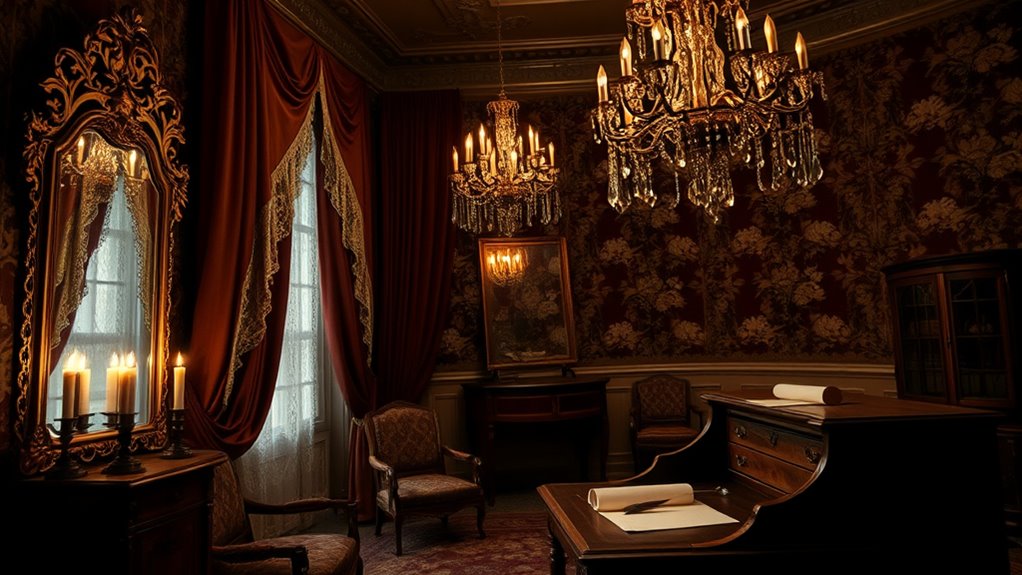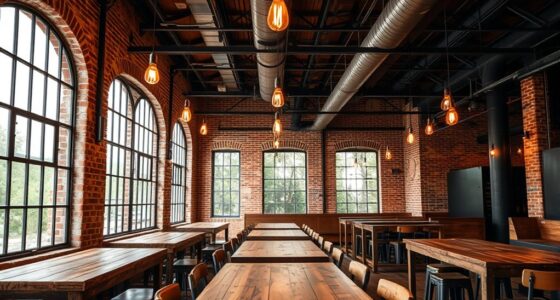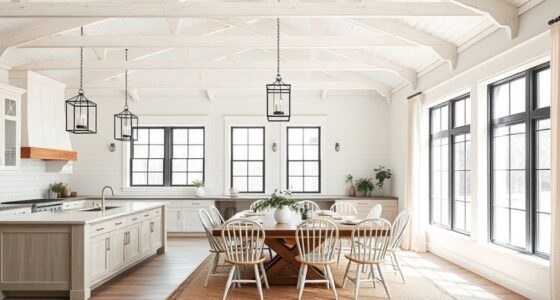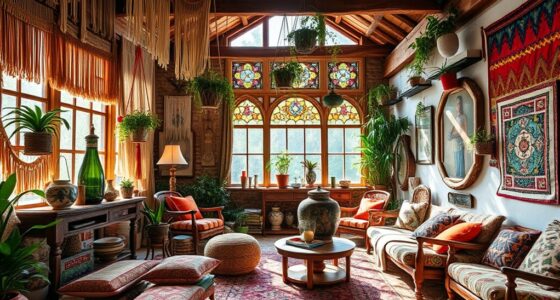Victorian style began in the UK during Queen Victoria’s reign, blending Gothic, Renaissance, and Rococo influences with the new materials of the Industrial Revolution, resulting in ornate architecture and rich interiors. Over time, regional variations emerged, from grand mansions to simpler townhouses. As the 20th century progressed, modernist minimalism replaced Victorian excess. To explore how this elaborate style rose, thrived, and ultimately declined, continue exploring its visual and cultural journey.
Key Takeaways
- Victorian style emerged in the UK during Queen Victoria’s reign, blending Gothic, Rococo, and Renaissance influences for eclectic designs.
- It flourished in the 19th century, characterized by ornate architecture, intricate ornamentation, and rich textiles in fashion and interiors.
- Industrial innovations enabled mass production of elaborate materials, making Victorian aesthetics widely accessible.
- Regional variations and eclectic influences allowed Victorian design to adapt to local climates, cultures, and materials.
- The style declined in the early 20th century amid changing tastes, modernist movements, and shifting societal values.
Origins and Early Influences of Victorian Architecture
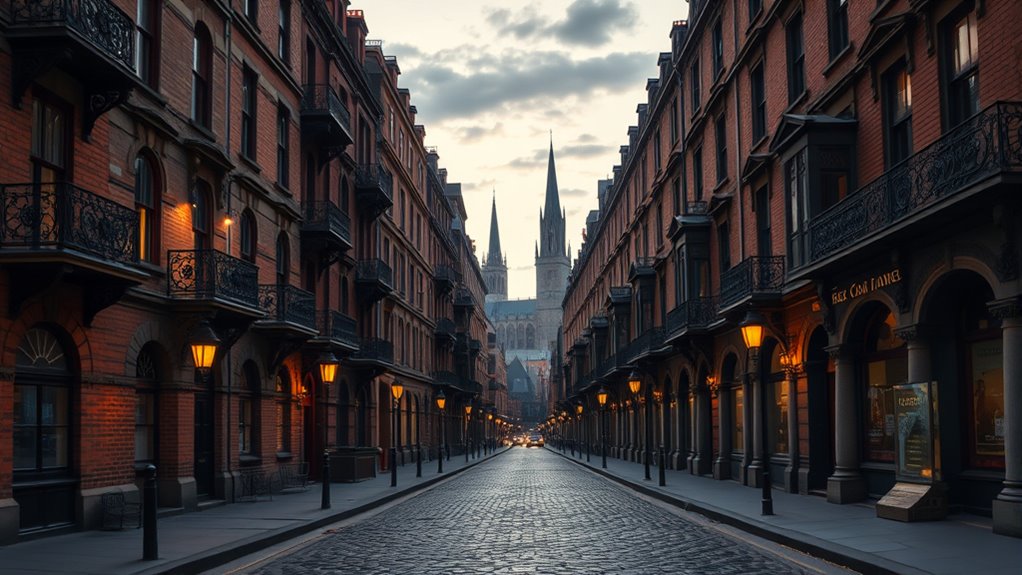
Victorian architecture began in the United Kingdom during Queen Victoria’s reign, blending Gothic, Rococo, and Renaissance styles to create eclectic designs. This period embraced innovation, driven by the Industrial Revolution, which made decorative materials like cast iron, glass, and ornate woodwork widely available. As a result, Victorian buildings often feature ornate facades, asymmetrical layouts, steep roofs, and intricate trim called “gingerbread” detailing. The Gothic Revival, a key influence during this era, emphasized pointed arches, detailed tracery, and vertical lines inspired by medieval architecture. These elements reflected society’s desire for grandeur, stability, and modernity. The combination of historic styles and new manufacturing techniques allowed Victorian architecture to stand out as both expressive and functional, with the use of self-watering plant pots exemplifying the period’s innovative approach to household design and convenience. The widespread adoption of new construction techniques also contributed to the distinctive and durable structures characteristic of the era.
Key Characteristics and Decorative Elements
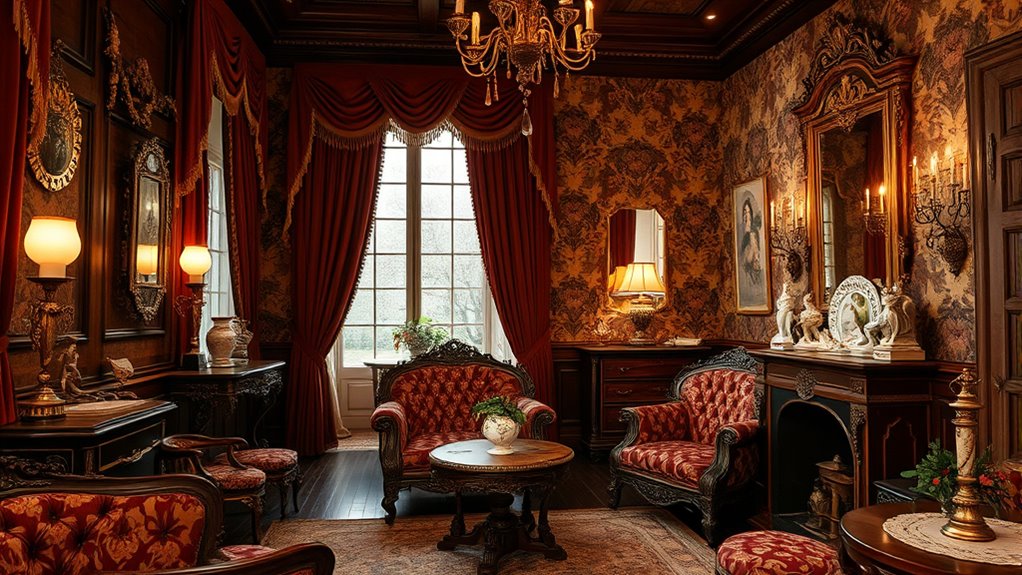
The elaborate decorative elements that define Victorian style make it instantly recognizable and richly detailed. Victorian style is filled with ornate architecture, featuring intricate moldings, decorative cornices, and elaborate facades decorated with scrolls, floral motifs, and patterned brickwork. Clothing and interiors showcase decorative embellishments like lace, embroidery, and layered trims, emphasizing craftsmanship and ornamentation. Fashion often incorporates rich fabrics such as silk and velvet, adorned with appliqué, sequins, and bows. Symmetry and complexity are key characteristics, with decorative accessories enhancing the overall aesthetic. These details reflect a love for ornate aesthetics, creating a sense of opulence and visual richness that remains a hallmark of Victorian design. Additionally, the use of decorative elements such as ornate furniture and detailed wall coverings further contributes to the style’s luxurious appearance. The integration of architectural details like stained glass windows and decorative ironwork also plays a significant role in defining the style’s grandeur. The Victorian era also embraced ornamental craftsmanship, which can be seen in the finely detailed woodwork and metalwork that adorn many interior spaces. Moreover, the use of patterned textiles in upholstery and drapery further enhances the style’s richness and texture.
The Impact of Industrialization on Design and Materials
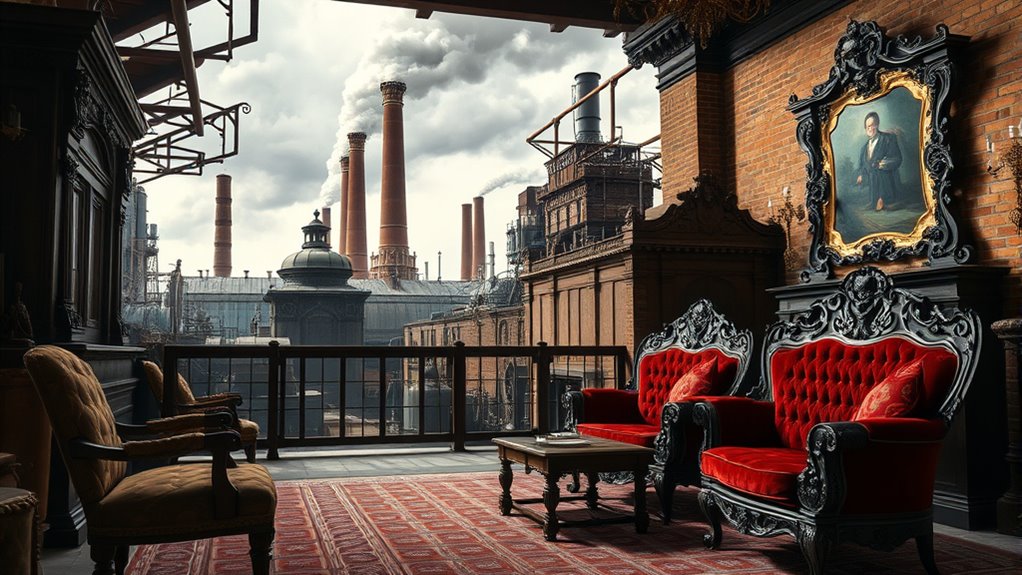
Industrialization transformed Victorian design by enabling mass production of textiles and garments, making elaborate fashions more accessible. The invention of the sewing machine and synthetic dyes introduced vibrant colors and faster manufacturing processes. These innovations allowed for more intricate and affordable styles to flourish across society. Additionally, the development of high-quality pigments improved the durability and richness of fabric dyes, further enhancing the appeal of Victorian fashion. The availability of chemical-based dyes also contributed to a wider palette of colors and consistent dyeing results, making fashionable textiles more uniform and desirable. The rise of energy-efficient appliances during later periods supported the maintenance and preservation of textiles and garments, ensuring their longevity. Moreover, the growth of advanced textile preservation techniques helped extend the life span of delicate fabrics and intricate garments, maintaining their aesthetic appeal over time. The rapid growth of AI-driven security systems in the later periods underscored the importance of safeguarding these increasingly complex and widespread textile industries from cyber threats.
Mass Production Techniques
Mass production techniques revolutionized the way clothing was made during the Victorian era by harnessing mechanization and factory systems. The invention of the sewing machine in the 1850s boosted the speed and efficiency of garment manufacturing, lowering costs and expanding access. Advances in textile machinery allowed for mass production of fabrics like muslin, silk, and lace, which became staples in Victorian fashion. Vibrant, consistent colors were now achievable thanks to synthetic dyes like mauveine, introduced in 1856. Department stores and mail-order catalogs emerged, making ready-to-wear Victorian styles available to a broader population. These innovations shifted clothing production from bespoke tailoring to large-scale manufacturing, creating uniformity and variety in Victorian fashion while making stylish garments more affordable and accessible to the masses. The widespread adoption of mass production techniques also facilitated the dissemination of Victorian style across different social classes, transforming fashion from an elite craft into a mass-market industry. Additionally, the use of industrialization in fabric and garment production enabled designers to experiment with new styles and patterns, further democratizing fashion during this period. The rise of factory systems helped standardize sizing and quality control, contributing to the overall consistency of mass-produced garments. Furthermore, labor specialization within factories allowed for increased efficiency and the development of distinct roles for workers involved in clothing production. This shift also led to the growth of a new industrial workforce, which was essential for sustaining the expanding production demands.
Synthetic Material Innovation
As advancements in chemical manufacturing unfolded during the Victorian era, they revolutionized textile design by enabling the creation of vibrant, durable, and colorfast fabrics. Synthetic fibers like rayon and early plastics emerged, opening new avenues for fashion and fabric production. The invention of synthetic dyes, such as mauveine in 1856, introduced bold, vivid colors that transformed Victorian textiles. Textile innovation also made fabrics more affordable, thanks to machine-made processes that lowered costs and increased accessibility for the middle class. These developments produced fabrics that resisted stains and maintained color over time, changing garment care and longevity. The rise of synthetic materials marked a shift away from traditional natural fabrics like silk and wool, shaping the future of textile industries and Victorian fashion. Understanding the impact of these innovations can be further appreciated through personality insights, which reveal how individual preferences and traits influence consumer choices and fashion trends during this transformative period. Additionally, the development of synthetic fabrics contributed to the emergence of new dog breed influences in fashion and accessories, reflecting societal trends and technological progress. Furthermore, advancements in Paint Sprayer Zone technology, such as improved filtration and tip selection, exemplify how industrial innovations continued to influence material and product development during this era. Moreover, the integration of AI-driven analytics in manufacturing processes during this period laid the groundwork for more efficient and innovative textile production methods. The evolution of vegetable juices, especially with modern techniques like cold-pressing, also highlights how technological progress has impacted health and wellness trends linked to textile and material industries.
Regional Variations and Adaptations
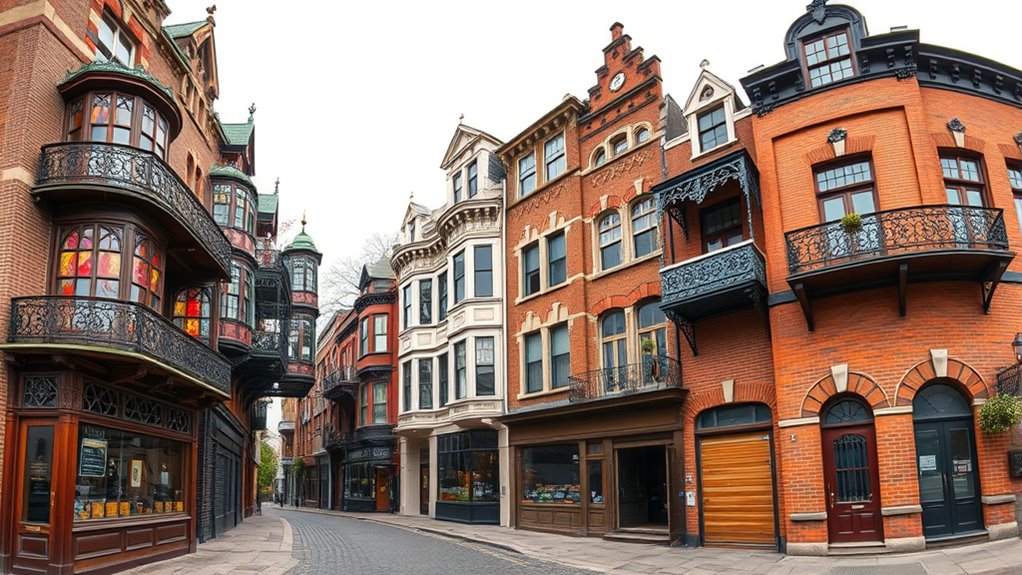
Victorian architecture showcases a rich diversity of regional styles that reflect local climates, materials, and cultural influences. These regional variations result in distinct adaptations across the United States and beyond. In the Northeast, ornate Queen Anne designs dominate, featuring intricate ornamentation, while rural Southern homes tend to be simpler, using local materials like wood. Climate and resources shaped the popularity of specific Victorian house types, such as Italianate and Second Empire styles, varying by region. Urban centers like Chicago developed unique adaptations, like steel-frame skyscrapers in the “Chicago School,” contrasting with rural areas’ functional structures. Migration and immigrant influences further blended Victorian aesthetics with local building traditions, creating a tapestry of architectural diversity that highlights the adaptability of Victorian style across different regions. Additionally, regional architectural styles often incorporated local craftsmanship and decorative elements, further enriching the Victorian architectural landscape. Understanding how regional influences impacted Victorian design can offer insights into the cultural history of these areas.
Victorian Residential Styles: From Townhouses to Mansions
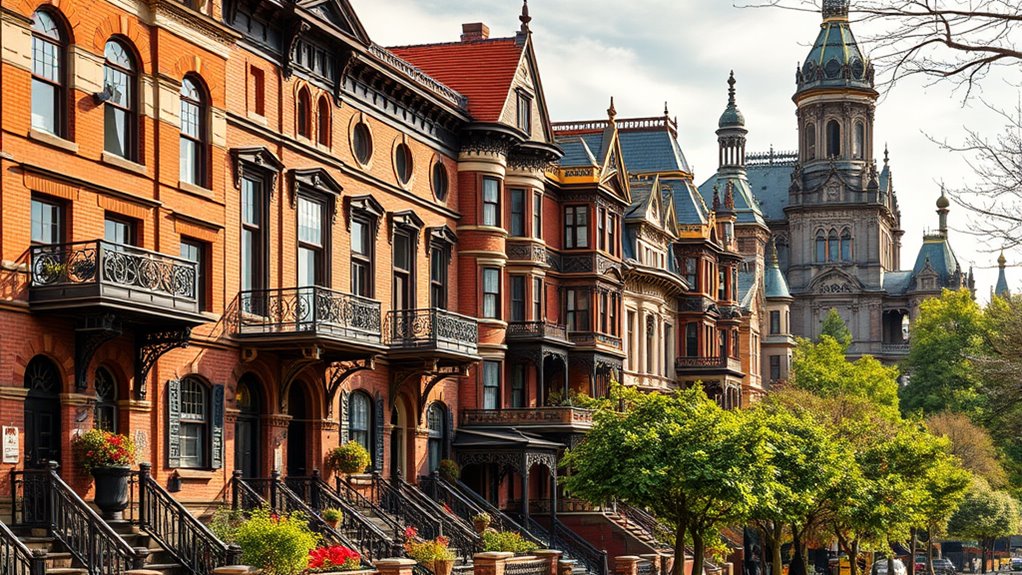
Victorian residential architecture is incredibly diverse, ranging from modest townhouses to grand mansions, each reflecting different social statuses and regional influences. Victorian townhouses, common in cities, feature brick facades, decorative trim, and small front gardens, serving urban middle-class families. The Queen Anne style, popular in the late 1800s, showcases asymmetrical facades, ornate gables, and expansive porches, adding charm to city homes. On the other end, Victorian mansions, often built in Gothic Revival or Italianate styles, include turrets, intricate woodwork, and large landscaped grounds, symbolizing wealth and social standing. Regional variations, like American Folk Victorian and Italianate villas, highlight how Victorian architecture adapted to local climates and materials, creating a rich tapestry of residential styles across the era.
Public Buildings and Commercial Architecture
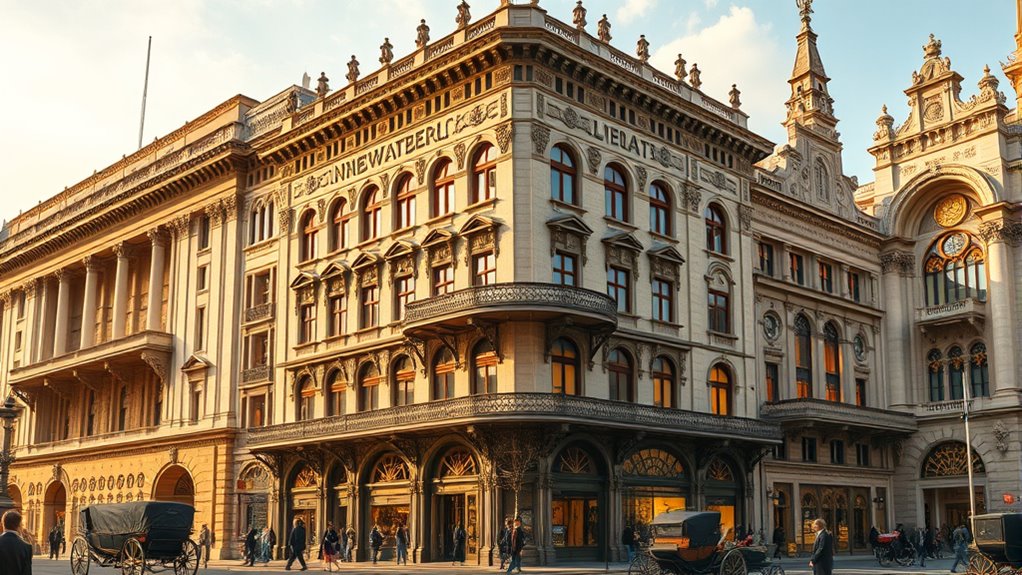
Have you ever noticed how public and commercial buildings from the Victorian era stand out with their ornate facades and intricate details? Victorian architecture often features decorative brackets, columns, and elaborate moldings that create a richly textured appearance. These structures frequently showcase polychromatic brickwork and terracotta ornamentation, adding vibrant color and depth. Architects drew inspiration from Gothic Revival, Romanesque, and Renaissance styles, resulting in a diverse visual language. Large windows, high ceilings, and spacious interiors were designed to serve civic and retail needs. Innovations like cast iron and steel framing enabled larger spans and more elaborate facades, heightening the grandeur of these buildings. Overall, Victorian public and commercial architecture exudes a sense of opulence and craftsmanship.
The Role of Ornamentation and Eclectic Influences
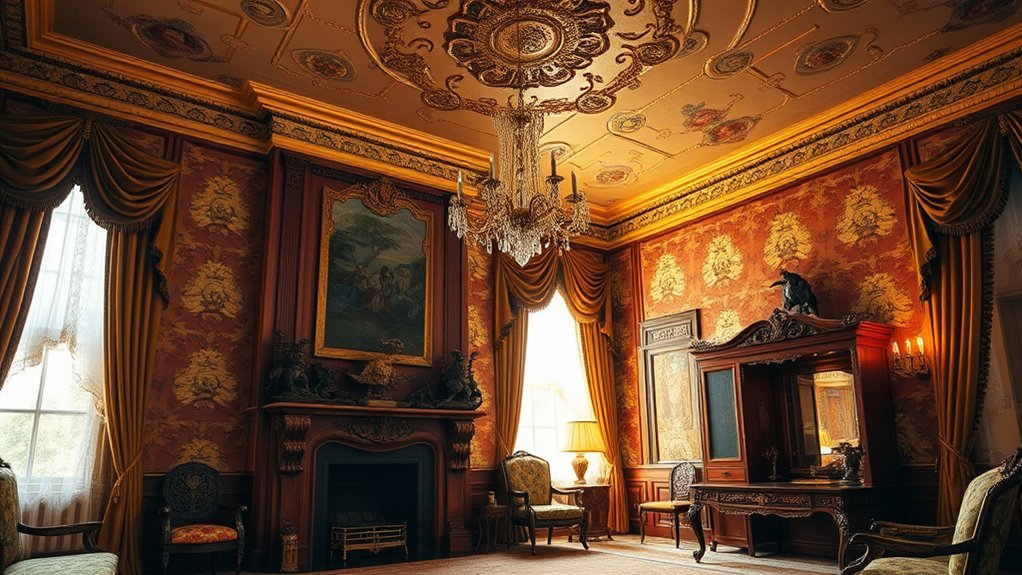
Ornamentation played a central role in shaping Victorian design, showcasing intricate lace-like patterns, embroidery, and elaborate embellishments that decorated both garments and architectural details. This era’s eclectic influences blended Gothic, Rococo, Renaissance, and Asian styles, creating visually diverse and ornate aesthetics. Your fashion choices featured lavish trimmings like ruffles, bows, and buttons, while architecture embraced decorative moldings, finials, and stained glass to boost visual richness. This maximalist approach layered textures and patterns, producing elaborate, stimulating compositions. The craftsmanship behind these details signified wealth and taste, with the most ornate styles reserved for the upper classes. This blending of ornamentation and eclectic influences defined Victorian aesthetics and reflected societal status.
| Ornamentation | Eclectic Influences |
|---|---|
| Intricate lace | Gothic, Rococo |
| Embroidery | Renaissance, Asian |
| Elaborate embellishments | Diverse styles |
The Transition Toward Modernist Simplicity
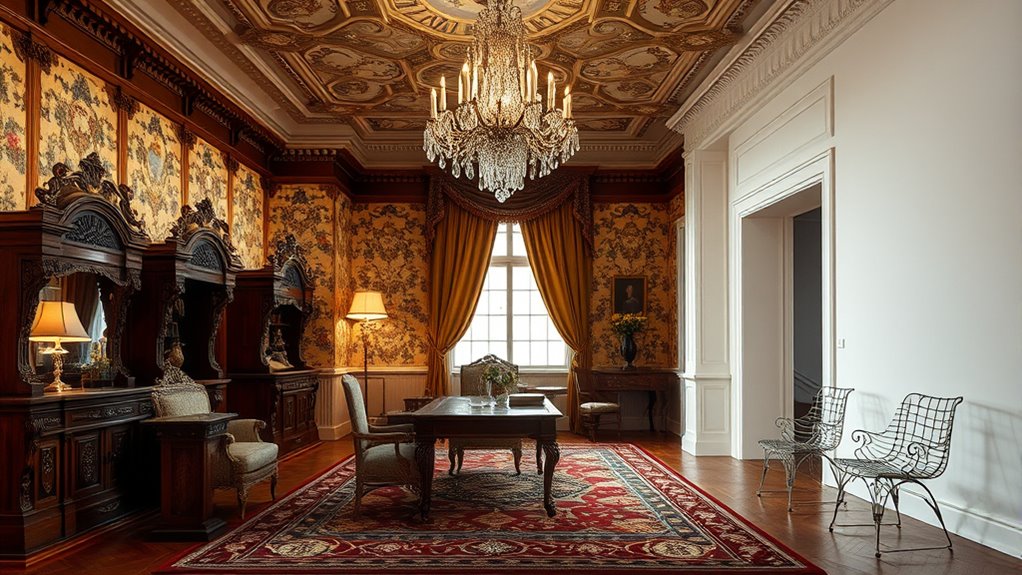
How did fashion and architecture shift from their ornate Victorian roots to embrace modernist simplicity? As modernism gained momentum in the early 20th century, both fields moved away from Victorian extravagance toward streamlined, functional designs. You’ll notice this change through:
- Victorian fashion giving way to lighter fabrics and less restrictive silhouettes
- Architectural innovations like steel framing enabling cleaner, minimalist forms
- Society valuing practicality and efficiency over ornate decoration
This shift reflected a broader societal move toward utilitarian aesthetics, emphasizing function over form. The ornate, symbolic Victorian style was replaced by sleek, straightforward designs that prioritized usability. Modernism’s influence made fashion and architecture more accessible and aligned with contemporary lifestyles, marking a clear break from Victorian grandeur.
Decline and the End of Victorian Architectural Dominance
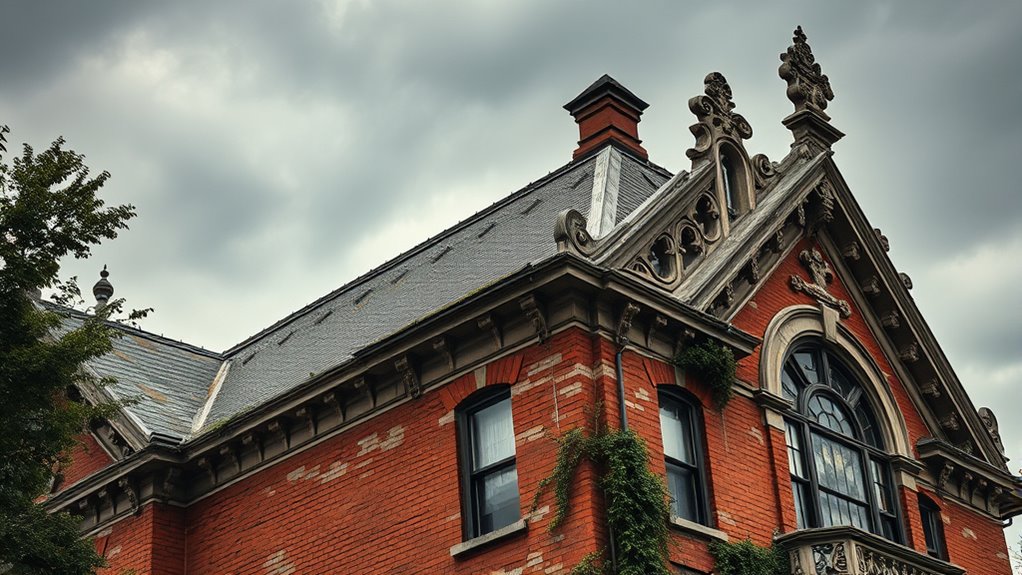
As modernist design principles gained popularity in the early 20th century, Victorian architecture’s dominance steadily waned. People began valuing simplicity and practicality over ornate decoration, shifting public taste away from Victorian aesthetic standards. Technological advances, like steel framing and better manufacturing, made streamlined, less decorative buildings more feasible. During urban renewal projects in the mid-20th century, many Victorian structures were demolished, further eroding their presence in cityscapes. By the 1920s and 1930s, Victorian architecture was largely replaced by styles like Art Deco, Modernist, and International Style, signaling the end of its architectural dominance. This shift reflected changing societal values and the desire for new, functional urban landscapes, marking the decline of the Victorian era’s influence on architecture.
The Lasting Legacy and Contemporary Appreciation
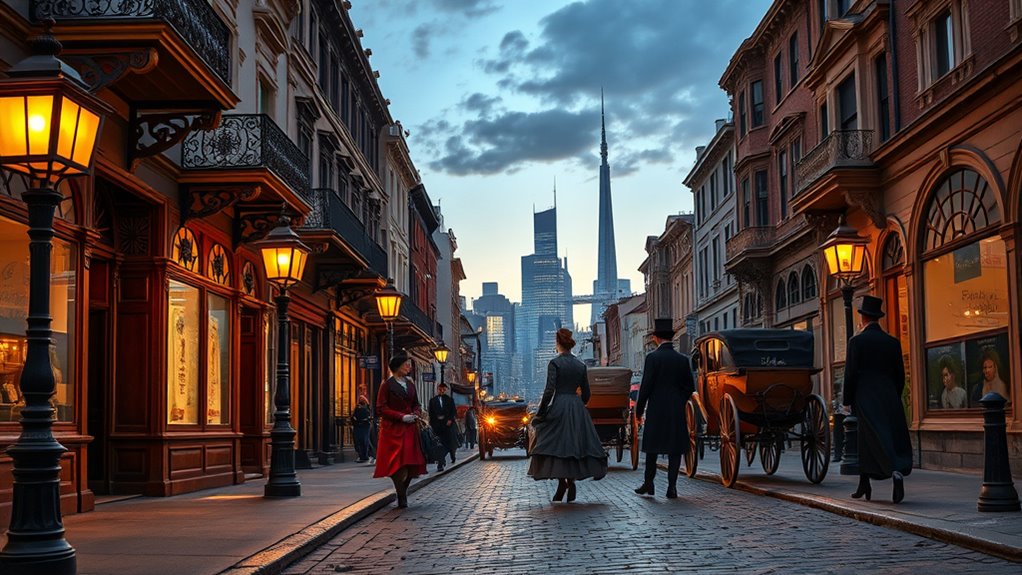
Even as Victorian architecture faded from mainstream urban landscapes, its influence continues to shape contemporary fashion and design. You’ll notice Victorian fashion’s intricate details and craftsmanship in modern vintage clothing and couture, emphasizing lace, corsetry, and ornate silhouettes. Designers often incorporate Victorian elements like high collars, bustle shapes, and decorative trims to evoke elegance. The popularity of Victorian-inspired vintage clothing and accessories reflects society’s fascination with the era’s artistry and symbolism. You might find yourself drawn to these styles in themed events or fashion statements. Victorian aesthetics also influence popular culture through films, theater, and design movements. This enduring legacy highlights how Victorian craftsmanship and elegance still inspire and resonate today.
- Vintage clothing with Victorian details remains trendy
- Modern designers evoke Victorian silhouettes and trims
- Victorian craftsmanship influences sustainable fashion practices
Frequently Asked Questions
What Is the Victorian Style Design History?
You’re curious about Victorian style design history. It emerged during Queen Victoria’s reign from 1837 to 1901, blending Gothic Revival, Rococo, and Renaissance influences into an ornate, eclectic aesthetic. You’ll notice intricate details in architecture like steep roofs and decorative gables, while interiors feature rich textiles and elaborate moldings. This style reflected societal values of status and craftsmanship, emphasizing decoration, luxury, and craftsmanship in both fashion and design.
What Is the History of the Victorian Era?
You’re curious about the Victorian era’s history. During this time, Queen Victoria’s reign from 1837 to 1901 brought rapid social, cultural, and technological changes. You see how urbanization and new inventions transformed daily life and fashion. Society emphasized morality and class distinctions, influencing dress and behavior. As the era ended around 1900, simpler, modern styles replaced the ornate, traditional Victorian look, reflecting shifting values and innovations.
What Is the Historical Context of Victorian Literature?
Think of Victorian literature as a mirror held up to society’s face during Queen Victoria’s reign. You see reflections of rapid industrialization, social reform, and class struggles, shaping stories that critique morality and explore human nature. As you read works by Dickens or the Brontës, you realize they’re capturing a world caught between tradition and modernity, revealing the complexities and contradictions of an era transforming at breakneck speed.
What Was the Victorian Era Impact?
You see, the Victorian era greatly impacted fashion, architecture, and societal norms. It emphasized grandeur and modesty, shaping how people dressed and built their surroundings. Technological advances allowed mass production, reinforcing social distinctions. This period’s influence still shows today in vintage fashion, design, and craftsmanship. As the era declined, society moved toward simplicity and practicality, marking a shift toward modern modernization and changing cultural values.
Conclusion
As you step back from Victorian architecture, you see a grand tapestry woven with intricate threads of innovation and ornament. Its ornate facades and eclectic details shimmer like a kaleidoscope frozen in time, reminding you of a vibrant era that shaped modern design. Though its dominance faded, the legacy remains etched in stone and spirit, a timeless mosaic whispering stories of craftsmanship and creativity that continue to inspire your appreciation today.
